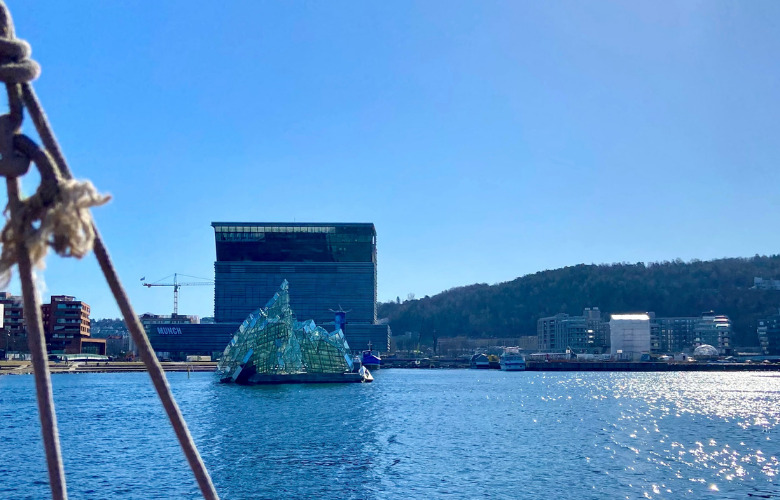
Shortly before his death, world-famous, Norwegian painter Edvard Munch willed all his works still in his possession to his hometown, Oslo. To honor this incredible gift, the original Munch Museum opened in 1963 with a unique collection of approximately 1’100 paintings, 4’500 drawings and 18’000 prints. On 22nd October 2021, the brand-new Munch Museum, now just called MUNCH, opened its doors to the world.
The works of Edvard Munch are well known all over the world. Most famous is his painting The Scream which nowadays is used in a myriad of memes on the internet.
Thankfully, Norwegians have a good sense of humor. Thus, instead of revering their famous painter in all seriousness, they too make the most of The Scream by selling all kinds of memorabilia featuring the painting with the caption “OMG, I’ve visited Norway.”
The old Munch Museum was already one of a kind. With hundreds of thousands of art connoisseurs visiting the city of Oslo each year just for a chance to immerse themselves in the giant universe of Munch’s original drawings and paintings… some of which are never shown anywhere else in the world.
Then, in 2008, Oslo’s city council decided to build a new museum for the incredible gift Edvard Munch had bestowed on his hometown.
An architectural competition for a new Munch Museum was announced. And, in 2009, an international jury named the proposal Lambda by Spanish architect Juan Herreros as the winner.
More than a decade later, in October last year, the world’s number one destination for experiencing Edvard Munch’s life and art – now simply and elegantly known as MUNCH – opened its doors to an expectant public.
Discussions and controversies about the new building were many. For some, it was a crooked, grey, horrendous, modern tower. A strange architectural design. Standing out as a sore thump, way too tall and intrusive, at Oslo’s picturesque waterfront.
For others, it was a triumph of modern design, propelling Edvard Munch, and art appreciation in general, into a new era.
MUNCH is sixty metres tall and constitutes an interesting counterpoint to nearby buildings, most notably to the horizontally oriented Oslo Opera House. With cladding in recycled, perforated and partially translucent aluminium panels and its characteristic leaning top section, the museum has become a distinctive Oslo landmark.
In an article from 25th October 2021, The Guardian describes the museum as such: “The £235m mega museum of the tormented Norwegian artist stands as an ominous grey tower on the Oslo waterfront. Lurching out at the top like a military lookout post, keeping watch over the fjord. It is a location scout’s dream for the ultimate villain’s headquarters. An almost comically menacing structure. Bent over the pristine white iceberg of the city’s beloved opera house with a thuggish hunch.”
The tower, which sits on a three-story podium, has two zones: one static and one dynamic.
The static zone is an enclosed concrete structure, which complies with stringent requirements in order to protect the art. The dynamic zone has an open, transparent facade with beautiful views over the city and the Oslo fjord.
With a total of 13 floors and 11 gallery spaces, MUNCH is able to offer a wide range of approaches to Edvard Munch and his art, and to juxtapose his oeuvre with those of other modernists and contemporary artists. The permanent exhibitions are drawn from Munch’s own collection, which for the first time really has the space it deserves.
In addition to regular exhibitions, the museum’s events programme will be filled with music, performances, film screenings and art talks.
To quote The Guardian once more, humorous and to the point: “The word museum has been dropped for a start. In an attempt to attract new audiences, who may be put off by the m-word, this is just MUNCH. Its punchy all-caps logo is slanted back 20 degrees to match the tilt of the tower, emblazoned across the facade in glowing, full storey-high letters. A promotional video sets the youth-oriented tone, featuring teens skateboarding towards the building, texting each other with scream emojis, on their way to hang out, not just look at paintings.”
Museum director Stein Olav Henrichsen promises that a brimming program of events and performances will “make this house lively from 10am to 10pm every day.”
It is most definitely a location in which it might be possible to spend one’s entire visit to Oslo… no matter how long one’s stay may be.
Official Website Munch Museum
Article in The Guardian: ‘We are more than just The Scream’: inside Oslo’s mega Munch Museum
MUNCH featured on Visit Oslo
Munch Museum on Wikipedia
A Journey Underwater with Ludovico Einaudi, in Oslo’s Konserthus
Bewegtes Land, an Art Project For Train Passengers


Liam Klenk was born in Central Europe and has since lived on four continents. Liam has always been engaged in creative pursuits, ranging from photography and graphic design, to writing short stories and poetry, to working in theatre and shows. In 2016, Liam published his first book and memoir, 'Paralian'.
Read Full Profile© 2021 TheatreArtLife. All rights reserved.

Thank you so much for reading, but you have now reached your free article limit for this month.
Our contributors are currently writing more articles for you to enjoy.
To keep reading, all you have to do is become a subscriber and then you can read unlimited articles anytime.
Your investment will help us continue to ignite connections across the globe in live entertainment and build this community for industry professionals.